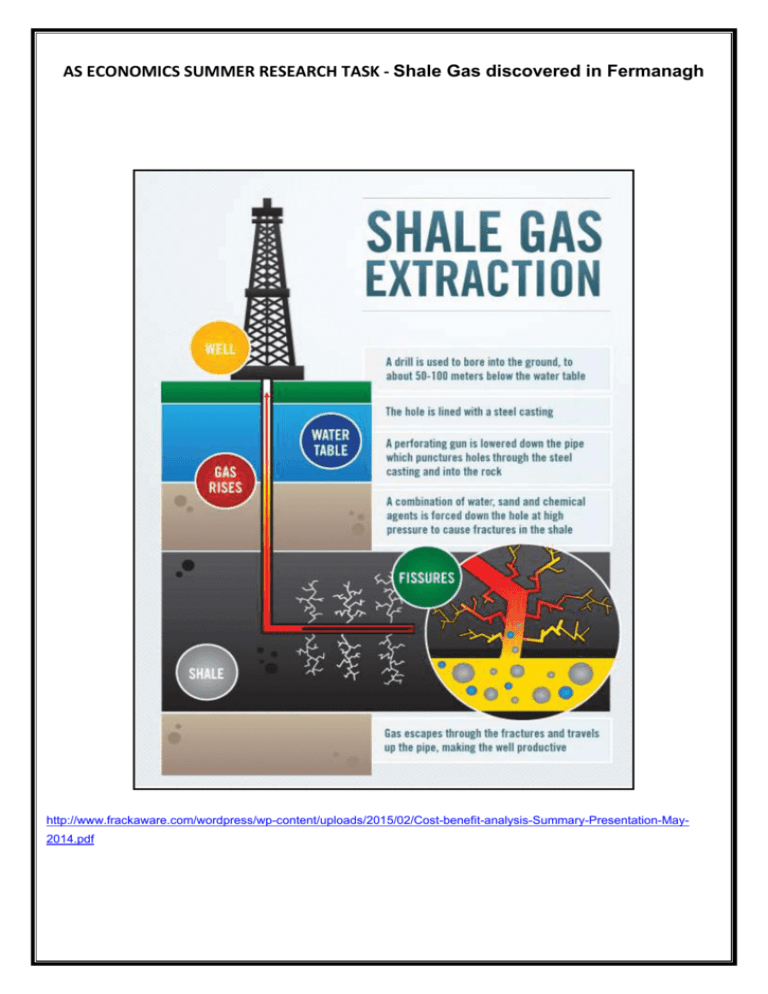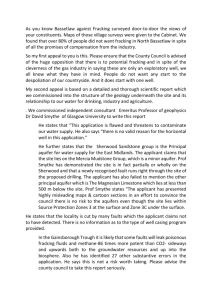Economics - Portora Royal School
advertisement

AS ECONOMICS SUMMER RESEARCH TASK - Shale Gas discovered in Fermanagh http://www.frackaware.com/wordpress/wp-content/uploads/2015/02/Cost-benefit-analysis-Summary-Presentation-May2014.pdf Please study the following passage carefully and answer the questions which follow: In 2012 it was announced that Australian exploration and mining company, Tamboran Resources, had identified a huge shale gas field in an area spanning counties Fermanagh, Sligo,Leitrim and Donegal. Tamboran’s environmental director, Tony Bazley, claimed that the gas reserves in Fermanagh could be enough to guarantee Northern Ireland’s gas supply for the next 50 years. Tamboran is hoping to obtain a licence to extract the gas in a £6bn investment which it claims will create 600 full time jobs. The news that there are large quantities of gas in this part of Ireland is not new. Indeed these reserves have been known about for decades. However it is only in the last few years that advances in technology have combined with high energy prices to make shale gas exploitation economically viable. Shale gas enthusiasts claim that its exploitation will bring a wide range of benefits to the Northern Ireland economy and further afield. They argue that the exploitation of the gas from the Fermanagh reserves will secure supplies for generations, lead to lower domestic energy prices, create thousands of jobs both directly and indirectly and, because natural gas is cleaner to burn than either coal or oil, will help Northern Ireland meet its EU carbon reduction targets. However, not everyone is in favour of exploiting these gas reserves. Much of the opposition is related to the process used to extract the gas from the shale rock, known as fracking. Fracking is short hand for hydraulic fracturing and refers to the process of drilling into the rock and pumping water, sand and a range of chemicals into the drill holes to cause a series of tiny explosions and release the gas trapped inside. This process is illustrated in the diagram. Reports from the US claim that fracking can cause poisonous chemicals to leak into local water supplies, with some American homeowners claiming that shale gas leaking into their drinking supply caused their tap water to ignite. Environmentalists are also concerned that the exploitation of shale gas may lead to market failure. The World Wide Fund for Nature (WWF) claims that fracking has been responsible for a series of minor earthquakes and that the environmental benefits of shale gas are overstated. A spokesman for WWF claimed “The shift to shale gas may have negative environmental impacts for two reasons. Firstly, by depressing energy prices, shale gas production may divert investment away from renewable energy sources. Secondly, shale gas wells leak significant amounts of methane gas, which is a potent greenhouse gas. When the methane leaks caused by fracking are taken into consideration, the atmospheric warming effects of shale gas are greater than that of coal”. Despite these environmental concerns, many in the business and farming communities in Fermanagh are in favour of extracting the shale gas. Peter Brewster, a local farmers’ representative stated, “You don’t have to have a PhD in economics to realise that the prosperity of an economy depends on its ability to make the best use of its scarce economic resources. Leaving this gas in the rocks would make no more sense than leaving crops in the ground to rot! Strictly enforced regulations, with the threat of large fines for firms who cause pollution, should be enough to reduce the negative externalities associated with shale gas extraction”. Answer in full the following questions: 1. Explain the factors which have led to shale gas production becoming economically viable. (4) 2. What are the benefits of shale gas exploitation? (8) 3. Explain why a move towards shale gas production could be considered to be bad for the environment. (8) 4. Suggest two policies the government could use to reduce the negative environmental impact of shale gas production. What are the potential problems with implementing each of these two policies? (10)







